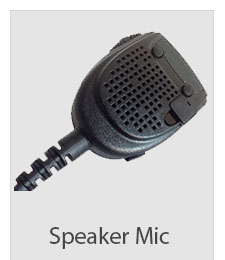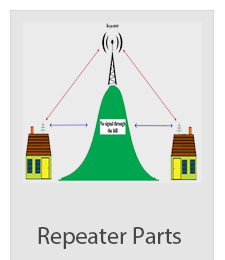What is CTCSS?
CTCSS stands for Continuous Tone Coded Squelch System.
Interference-Elimination Codes, sometimes refer to Tone Squelch, TalkGroup or Privacy Code.
It works like Key and Lock on Door. Walkie Talkie transmits sub-audible tone (Key) and opens the door (Lock) on Receiver. For example: Group A on Ch1 no CTCSS, Group B on Ch1 Code1, Group C on Ch1 Code38. Group B won/'/t be bothered by Group A (no Keys) C (wrong Key). Group A can hear all groups because no Lock (incoming door is open).
Keep in mind that this feature doesn/'/t actually protect your privacy. As you see Group A who turned off CTCSS can hear all in the same channel. In addition, anyone who has chosen the same channel and code as you can still transmit to your radio.
CTCSS Blocking
CTCSS stands for Continuous Tone Coded Squelch System, but for most non-technical people, knowing the full glorious name of this system doesn't really aid much in the understanding of it.
Many people completely misunderstand what this is and does - including, unfortunately, many people who describe and review these radios.
So let's first understand what they don't do.
CTCSS does NOT give you privacy
Using a CTCSS code on your radio does not mean that other people can't hear what you are saying. It means you can't hear what they are saying, but it does not mean they can't hear what you are saying.
CTCSS does NOT give you more channels
We've seen people who multiple the channels by the CTCSS codes (eg 22 x 38 = 836) and marvel at the number of different 'channels' to choose from, saying words to the effect 'With 836 different channels to choose from, you don't need to worry about congestion or other users'.
This is nonsense. All the other users are still sharing the same channel - just because you can't hear them doesn't mean they're not there, and your signals have no priority over theirs when you come to transmit.
So, having hopefully debunked these two myths, let's now see what CTCSS does do.
What CTCSS does
When activated, CTCSS sends a tone along with your voice whenever you send a transmissions. This tone is not normally audible, but it is detected by the receiving radio.
If the receiving CTCSS is switched on, it listens for the tone. If it is the tone that it has been told to accept, it will then play the broadcast over its speaker. But if the tone is a different frequency, it will ignore the message.
This means that the person listening to their receiver is not bothered by people who are not intending to communicate with him, because they are either using no tone at all (with CTCSS switched off) or a different tone.
However, there is still only one channel, and only one person can broadcast on it at any one time. The different tones don't enable multiple transmissions to occur simultaneously, and if that should happen, they will still interfere with each other, no matter if they are using tones or not.
And if a person switches off the CTCSS on their receiver, they can hear all transmissions, no matter what the tone that might be used, on a given channel.
The problem with CTCSS
Different systems use different sets of tone frequencies. The most common system uses 38 tones, but there are a number of other 'standards' out there too.
So there is the problem. If your radio uses one set of tones, and the other radio you are trying to communicate with uses a different set of tones, they are probably not going to be able to talk to each other unless you both switch off your CTCSS function.
DCS Blocking
DCS stands for Digital Coded Squelch, and it can be thought of as being identical in function to CTCSS, but using a slightly different method of signalling. Instead of adding a tone to the transmission, DCS sends a digital code.
DCS blocking has exactly the same limitations and challenges as CTCSS, and can be available in over 100 different codings.
Making things even more complex are some radios that have both CTCSS and DCS on them! That starts to really make for complexities upon complexities. Multiple perhaps 40 CTCSS codes with perhaps 100 DCS codes, and that gives you 4,000 different ways to limit what you can hear on each channel (but remember, although it limits what you hear, it doesn't limit what other people can hear if they have turned off their CTCSS and DCS controls). Multiply that by perhaps 22 channels at you are at almost 100,000 different combinations of channel, CTCSS and DCS code.
The best thing to do with CTCSS, DCS, and any other similar features is to turn them off. Maybe, once you've verified you can at least get to the same channel, then you might experiment with one of these extra features, but until you have regular communication goin
CTCSS 38ch Standard Frequency Table
CTCSS
FRS No. |
Hz |
CTCSS
FRS ch |
Hz |
| 1 |
67.0 |
20 |
131.8 |
| 2 |
71.9 |
21 |
136.5 |
| 3 |
74.4 |
22 |
141.3 |
| 4 |
77.0 |
23 |
146.2 |
| 5 |
79.7 |
24 |
151.4 |
| 6 |
82.5 |
25 |
156.7 |
| 7 |
85.4 |
26 |
162.2 |
| 8 |
88.5 |
27 |
167.9 |
| 9 |
91.5 |
28 |
173.8 |
| 10 |
94.8 |
29 |
179.9 |
| 11 |
97.4 |
30 |
186.2 |
| 12 |
100.0 |
31 |
192.8 |
| 13 |
103.5 |
32 |
203.5 |
| 14 |
107.2 |
33 |
210.7 |
| 15 |
110.9 |
34 |
218.1 |
| 16 |
114.8 |
35 |
225.7 |
| 17 |
118.8 |
36 |
233.6 |
| 18 |
123.0 |
37 |
241.8 |
| 19 |
127.3 |
38 |
250.3 |
CDCSS
| Standard(N) |
|
|
Standard(N) |
|
|
Standard(N) |
|
|
Standard(N) |
|
| 23 |
23 |
143 |
143 |
|
266 |
465 |
465 |
| 25 |
25 |
|
145 |
271 |
271 |
466 |
466 |
| 26 |
26 |
152 |
152 |
|
274 |
503 |
503 |
| 31 |
31 |
155 |
155 |
306 |
306 |
506 |
506 |
| 32 |
32 |
156 |
156 |
311 |
311 |
516 |
516 |
| |
36 |
162 |
162 |
315 |
315 |
532 |
532 |
| 43 |
43 |
165 |
165 |
|
325 |
546 |
546 |
| 47 |
47 |
172 |
172 |
331 |
331 |
565 |
565 |
| 51 |
51 |
174 |
174 |
|
332 |
606 |
606 |
| |
53 |
205 |
205 |
343 |
343 |
612 |
612 |
| 54 |
54 |
|
212 |
346 |
346 |
624 |
624 |
| 65 |
65 |
223 |
223 |
351 |
351 |
627 |
627 |
| 71 |
71 |
|
225 |
|
356 |
631 |
631 |
| 72 |
72 |
226 |
226 |
364 |
364 |
632 |
632 |
| 73 |
73 |
243 |
243 |
365 |
365 |
654 |
654 |
| 74 |
74 |
244 |
244 |
371 |
371 |
662 |
662 |
| 114 |
114 |
245 |
245 |
411 |
411 |
664 |
664 |
| 115 |
115 |
|
246 |
412 |
412 |
703 |
703 |
| 116 |
116 |
251 |
251 |
413 |
413 |
712 |
712 |
| |
122 |
|
252 |
423 |
423 |
723 |
723 |
| 125 |
125 |
|
255 |
431 |
431 |
731 |
731 |
| 131 |
131 |
261 |
261 |
432 |
432 |
732 |
732 |
| 132 |
132 |
263 |
263 |
445 |
445 |
734 |
734 |
| 134 |
134 |
265 |
265 |
464 |
464 |
743 |
743 |
| |
754 |
754 |
|

















